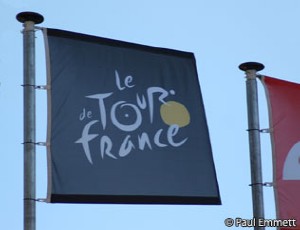Movement in the peloton to blame for series of crashes not narrow roads, says race director
 The Tour de France organisers have been criticised by a number of people over the route of stage five, between Carhaix and Cap Fréhel, after the day was marred by a number of big crashes. Among the big names to come down were race favourite Alberto Contador (Saxo Bank-SunGard), 2005 World champion Tom Boonen and French champion Sylvain Chavanel (Quick Step) and Rabobank captain Robert Gesink.
The Tour de France organisers have been criticised by a number of people over the route of stage five, between Carhaix and Cap Fréhel, after the day was marred by a number of big crashes. Among the big names to come down were race favourite Alberto Contador (Saxo Bank-SunGard), 2005 World champion Tom Boonen and French champion Sylvain Chavanel (Quick Step) and Rabobank captain Robert Gesink.
The most seriously affected were Janez Brajkovic (RadioShack) and Ivan Velasco (Euskaltel-Euskadi), who both suffered broken collarbones; Brajkovic was forced to abandon during the stage, while Velasco finished but will not start today.
Quick Step manager Patrick Lefevere was particularly incensed, according to Sporza, having seen his team’s two biggest names almost knocked out of the race.
“I know that the can tolerate little criticism, but this was irresponsible,” he told Het Laatste Nieuws. “Instead of sending us to tourist sites, the organisation would do better to look for ways in which a peloton of 200 riders can race.
“Just ask around in the peloton,” he added. “Everyone will agree with me.”
Tour de France race director Jean-François Pescheux has defended the choice of roads though, emphasising that, while rider safety is important, sometimes it is not possible to avoid routing the race along narrow roads.
“It’s not always easy to map out a course,” Pescheux told the Gazet van Antwerpen. “For a course to go from point A to point B there are not fifty possibilities. Sometimes we have to make the peloton race along narrower roads, but I always try my best to select the safest way.”
While it can be hazardous for a speeding peloton to race along narrow, winding country roads, Pescheux did point out that this was not where most of the serious incidents in Wednesday’s stage occurred.
“It’s strange that the crashes on Wednesday were not due to obstacles, but on straight roads,” he said. “This is probably due to movement in the peloton.”
In fact very few of the major incidents happened on what could be described as dangerous roads. The incidents involving Contador, Boonen, Chavanel, Gesink and Brajkovic all happened on the relatively wide, straight D9 road in the middle of the stage, shortly after the intermediate sprint at Goudelin.
The incidents involving Gesink, Brajkovic and Contador occurred as the peloton was slowing down after the sprinters had been battling for sprint points. While Contador was being paced back up to the peloton the pace went up again; almost as soon as he’d rejoined it slowed down again. This was where the Boonen crash happened.
As well as the changing pace in the peloton though, the typical Breton weather was undoubtedly a factor.
“There were strong winds here and there,” Pescheux admitted.